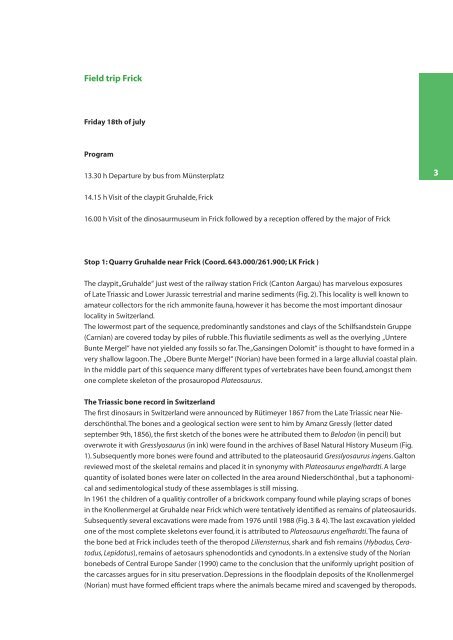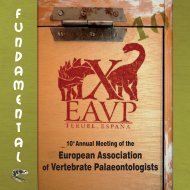1stEAVP MEETING BASEL
1stEAVP MEETING BASEL
1stEAVP MEETING BASEL
- No tags were found...
You also want an ePaper? Increase the reach of your titles
YUMPU automatically turns print PDFs into web optimized ePapers that Google loves.
Field trip FrickFriday 18th of julyProgram13.30 h Departure by bus from Münsterplatz314.15 h Visit of the claypit Gruhalde, Frick16.00 h Visit of the dinosaurmuseum in Frick followed by a reception offered by the major of FrickStop 1: Quarry Gruhalde near Frick (Coord. 643.000/261.900; LK Frick )The claypit „Gruhalde“ just west of the railway station Frick (Canton Aargau) has marvelous exposuresof Late Triassic and Lower Jurassic terrestrial and marine sediments (Fig. 2). This locality is well known toamateur collectors for the rich ammonite fauna, however it has become the most important dinosaurlocality in Switzerland.The lowermost part of the sequence, predominantly sandstones and clays of the Schilfsandstein Gruppe(Carnian) are covered today by piles of rubble. This fluviatile sediments as well as the overlying „UntereBunte Mergel“ have not yielded any fossils so far. The „Gansingen Dolomit“ is thought to have formed in avery shallow lagoon. The „Obere Bunte Mergel“ (Norian) have been formed in a large alluvial coastal plain.In the middle part of this sequence many different types of vertebrates have been found, amongst themone complete skeleton of the prosauropod Plateosaurus.The Triassic bone record in SwitzerlandThe first dinosaurs in Switzerland were announced by Rütimeyer 1867 from the Late Triassic near Niederschönthal.The bones and a geological section were sent to him by Amanz Gressly (letter datedseptember 9th, 1856), the first sketch of the bones were he attributed them to Belodon (in pencil) butoverwrote it with Gresslyosaurus (in ink) were found in the archives of Basel Natural History Museum (Fig.1). Subsequently more bones were found and attributed to the plateosaurid Gresslyosaurus ingens. Galtonreviewed most of the skeletal remains and placed it in synonymy with Plateosaurus engelhardti. A largequantity of isolated bones were later on collected In the area around Niederschönthal , but a taphonomicaland sedimentological study of these assemblages is still missing.In 1961 the children of a qualitiy controller of a brickwork company found while playing scraps of bonesin the Knollenmergel at Gruhalde near Frick which were tentatively identified as remains of plateosaurids.Subsequently several excavations were made from 1976 until 1988 (Fig. 3 & 4). The last excavation yieldedone of the most complete skeletons ever found, it is attributed to Plateosaurus engelhardti. The fauna ofthe bone bed at Frick includes teeth of the theropod Liliensternus, shark and fish remains (Hybodus, Ceratodus,Lepidotus), remains of aetosaurs sphenodontids and cynodonts. In a extensive study of the Norianbonebeds of Central Europe Sander (1990) came to the conclusion that the uniformly upright position ofthe carcasses argues for in situ preservation. Depressions in the floodplain deposits of the Knollenmergel(Norian) must have formed efficient traps where the animals became mired and scavenged by theropods.




